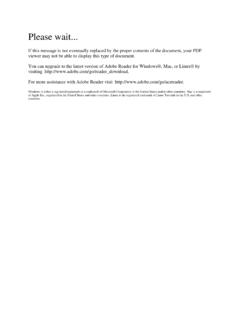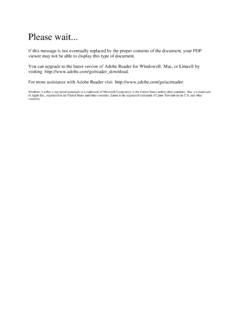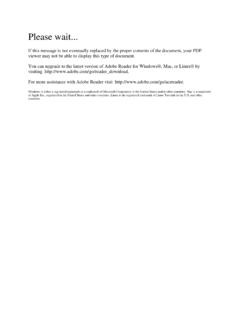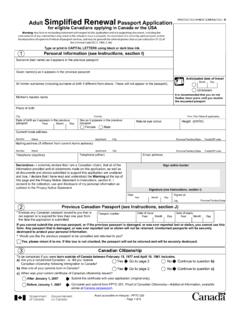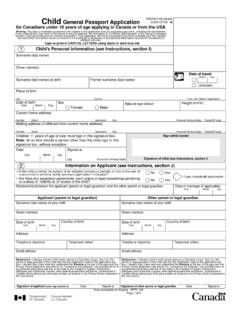Transcription of The New Food Guide - Canada
1 The New food Guide Health Canada Office of Nutrition Policy and Promotion 2019 2 Background Evidence and engagement What s new with Canada s food Guide For health professionals and policy makers For Canadians Summary and next steps Overview Background 3 4 Integrated widely by governments and stakeholders into nutrition policies, programs, and resources. Taught in schools and promoted by health professionals when supporting Canadians to eat well. Can help influence the foods served and sold in Canada s public institutions from day cares and schools, to long-term care facilities, as well as the foods Canadians choose for themselves and their families. Why the food Guide Matters to Canadians 5 Why Healthy Eating Information Matters Disease Risk Unhealthy diet is a primary risk factor for disease burden in Canada Complex Nutrition information can be difficult to use and understand Confusing Conflicting healthy eating messages are everywhere Credible Canadians need credible healthy eating information 6 To address challenges for users such as: applying recommendations in every day life, including building healthy meals and snacks providing the right information to the right audience To ensure alignment with most current evidence on topics such as sodium, saturated fat and sugars.
2 Why Revise? 7 Evidence and Engagement 8 Solid Evidence The best available evidence was considered, including: only high-quality scientific reports on food and health from respected authorities including systematic reviews on over 100 food -related topics over 400 convincing conclusions The Evidence Review for Dietary Guidance 2015 and the food , Nutrients and Health: Interim Evidence Update 2018, form the foundation of the new food Guide . Industry-commissioned reports were excluded to reduce the potential for, or the perception of, conflict of interest. 9 Responsible and Meaningful Engagement Consulted extensively to ensure resources are evidence based, useful, and relevant to Canadians.
3 Online public consultations with Canadians and interested stakeholders helped to identify needs and expectations. To help communicate the guidance accurately, targeted consultations were held with: academics Indigenous experts provincial and territorial governments other federal departments National Indigenous Organizations health professional regulatory bodies/organizations and health charities 10 Submissions received during public consultations were summarized in What We Heard reports available at When Health Canada senior officials met with organizations to discuss the development of the food Guide , details including the name of the organization and purpose of meeting, were posted on Health Canada s Office of Nutrition Policy and Promotion officials responsible for drafting the food Guide did not meet with industry representatives to discuss the food Guide .
4 Openness and Transparency 11 Relevant and Useful User-Centred Public opinion research and consultations to understand how healthy eating information is used Diversity Tested with a range of ages, household incomes, locations, education levels, and cultural backgrounds Considerations Determinants of health, the environment, and cultural diversity, including social, cultural and historical context of Indigenous Peoples Health Literacy Lens applied throughout the crafting and testing of messages What s New with Canada s food Guide ? 12 13 The new food Guide is an online suite of resources that better meets the needs of different users including the general public, policy makers, and health professionals.
5 Highlights include: Actionable advice for Canadians on healthy food choices and healthy eating habits including cooking more often and being mindful of eating habits Updated recommendations on saturated fat, sodium, and sugars including guidance on confectioneries and sugary drinks such as soft drinks, sweetened milk and juice Mobile-responsive web content to support Canadians to eat healthy whenever, and wherever they go Canada s food Guide at a Glance 14 Online Resources Available in English and French Canada s Dietary Guidelines for Health Professionals and Policy Makers food Guide snapshot Videos, recipes and actionable advice Evidence including the Evidence Review for Dietary Guidance 2015 and the food , Nutrients and Health: Interim Evidence Update 2018 15 As part of reconciliation, the Government of Canada acknowledges that program and policy making must support self-determination, as well as recognize the distinct nature and lived experience of First Nations, Inuit and M tis.
6 The integration of Indigenous considerations has been informed through engagement with Indigenous academics, health professionals and National Indigenous Organizations. Input to Canada s Dietary Guidelines addressed the social, cultural and historical factors that are determinants of healthy eating and that may influence the application of dietary guidance in Indigenous populations. Indigenous health professionals and health professionals with experience and expertise working with Indigenous populations provided input to inform the food Guide snapshot. Considerations for Indigenous Peoples 16 Canada s Dietary Guidelines For Health Professionals and Policy Makers For use when developing policies, programs, and educational resources.
7 Forms the foundation for the food Guide resources. Provides guidance on: Nutritious foods and beverages that are the foundation for healthy eating Foods and beverages that can have a negative impact on health when consumed on a regular basis food skills as a practical way to support healthy eating Supportive environments for healthy eating 17 Guideline 1: Foundation for healthy eating Vegetables, fruit, whole grains, and protein foods should be consumed regularly. Among protein foods, consume plant-based more often. Why? Patterns of eating that emphasize plant-based foods typically result in higher intakes of vegetables and fruit, nuts, soy protein, and fibre; and lower intake of processed meats and foods that contain mostly saturated fat.
8 Eating more vegetables and fruit is linked to a lower risk of cardiovascular disease. Eating more nuts or soy protein is linked to improved blood lipid levels. Higher fibre intake is linked to improved blood lipid levels and a lower risk of cardiovascular disease, colon cancer, and type 2 diabetes. Processed meat has been linked to colorectal cancer and foods that contain mostly saturated fat are linked to unfavourable blood lipid levels and a higher risk of type 2 diabetes. Protein foods include legumes, nuts, seeds, tofu, fortified soy beverage, fish, shellfish, eggs, poultry, lean red meat including wild game, lower fat milk, lower fat yogurts, lower fat kefir, and cheeses lower in fat and sodium.
9 18 Guideline 1: Foundation for healthy eating Foods that contain mostly unsaturated fat should replace foods that contain mostly saturated fat. Why? Cardiovascular disease is one of the leading causes of death in Canada . Lowering the intake of saturated fat by replacing it with unsaturated fat decreases total and LDL-cholesterol. Elevated LDL-cholesterol is a well-established risk factor for cardiovascular disease. The intention is not to reduce total fat in the diet. Rather, it is to help reduce intakes of saturated fat, while encouraging foods that contain mostly unsaturated fat. 19 Guideline 1: Foundation for healthy eating Water should be the beverage of choice. Why? Water supports health and promotes hydration without adding calories to the diet.
10 Water is essential for metabolic and digestive processes. Adequate intake is based on the total water required to prevent the effects of dehydration. 20 Guideline 2: Foods and beverages that undermine healthy eating Processed or prepared foods and beverages that contribute to excess sodium, free sugars, or saturated fat undermine healthy eating and should not be consumed regularly. Why? Canadians are purchasing more highly processed foods. When consumed on a regular basis, they can contribute to excess sodium, sugars, or saturated fat. These nutrients are linked to chronic disease risk when consumed in excess. 21 Guideline 2: Foods and beverages that undermine healthy eating Considerations There are health risks associated with alcohol consumption.
